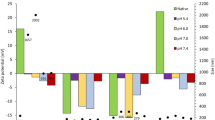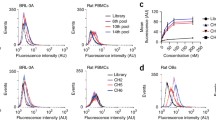Abstract
Gene therapy has emerged as a tool for the treatment of systemic metabolic disorders as osteoporosis (OP). However, the design of a suitable vehicle able to efficiently load and release the genetic material on the target cells is still a challenge. Moreover, the internalization pathway of nanosystems has been described to be dependent on their surface characteristics and the cell type evaluated. In this study, we aim at obtaining PEGylated lipid-PLGA nanoparticles (NPs) with variable surface charge able to incorporate GapmeRs (single-strand antisense oligonucleotides) for OP treatment. Nanoparticles showing negative, positive, and neutral surface charge were obtained by modulating the lipid composition. All formulations showed a remarkably low polydispersity index with adequate size. NPs were loaded with GapmeRs showing a high encapsulation efficiency and a surface charge–independent oligonucleotide loading. All the formulations were adequately internalized by MSCs. Future experiments will be devoted to use the developed formulations to clarify if the intracellular distribution of hybrid NPs on mesenchymal stem cells (MSCs) is dependent on surface charge. This portfolio of NPs will serve as a tool to analyze the effect of NP surface charge on gene therapy efficiency.
Graphical abstract






Similar content being viewed by others
Data availability
Full database will be available after request.
References
Kanis JA, Cooper C, Rizzoli R, Reginster JY. European guidance for the diagnosis and management of osteoporosis in postmenopausal women. Osteoporosis international : a journal established as result of cooperation between the European Foundation for Osteoporosis and the National Osteoporosis Foundation of the USA. 2019;30(1):3–44. https://doi.org/10.1007/s00198-018-4704-5.
Cheng C, Wentworth K, Shoback DM. New frontiers in osteoporosis therapy. Annu Rev Med. 2020;71:277–88. https://doi.org/10.1146/annurev-med-052218-020620.
García-García P, Ruiz M, Reyes R, Delgado A, Évora C, Riancho JA et al. Smurf1 silencing using a LNA-ASOs/lipid nanoparticle system to promote bone regeneration. 2019;8(12):1306–17. https://doi.org/10.1002/sctm.19-0145.
Lundin KE, Gissberg O, Smith CI. Oligonucleotide therapies: the past and the present. Hum Gene Ther. 2015;26(8):475–85. https://doi.org/10.1089/hum.2015.070.
Juliano RL. The delivery of therapeutic oligonucleotides. Nucleic Acids Res. 2016;44(14):6518–48. https://doi.org/10.1093/nar/gkw236.
Abewe H, Deshmukh S, Mukim A, Beliakova-Bethell N. Use of GapmeRs for gene expression knockdowns in human primary resting CD4+ T cells. J Immunol Methods. 2020;476:112674. https://doi.org/10.1016/j.jim.2019.112674.
Machado Cruz R, Santos-Martinez MJ, Tajber L. Impact of polyethylene glycol polymers on the physicochemical properties and mucoadhesivity of itraconazole nanoparticles. European journal of pharmaceutics and biopharmaceutics : official journal of Arbeitsgemeinschaft fur Pharmazeutische Verfahrenstechnik eV. 2019;144:57–67. https://doi.org/10.1016/j.ejpb.2019.09.004.
Patra JK, Das G, Fraceto LF, Campos EVR, Rodriguez-Torres MDP, Acosta-Torres LS, et al. Nano based drug delivery systems: recent developments and future prospects. J Nanobiotechnol. 2018;16(1):71. https://doi.org/10.1186/s12951-018-0392-8.
Rouco H, Diaz-Rodriguez P, Rama-Molinos S, Remuñán-López C, Landin M. Delimiting the knowledge space and the design space of nanostructured lipid carriers through Artificial Intelligence tools. Int J Pharm. 2018;553(1):522–30. https://doi.org/10.1016/j.ijpharm.2018.10.058.
Godara S, Lather V, Kirthanashri SV, Awasthi R, Pandita D. Lipid-PLGA hybrid nanoparticles of paclitaxel: Preparation, characterization, in vitro and in vivo evaluation. Mater Sci Eng C Mater Biol Appl. 2020;109:110576. https://doi.org/10.1016/j.msec.2019.110576.
Du XJ, Wang JL, Iqbal S, Li HJ, Cao ZT, Wang YC, et al. The effect of surface charge on oral absorption of polymeric nanoparticles. Biomater Sci. 2018;6(3):642–50. https://doi.org/10.1039/c7bm01096f.
Rees P, Wills JW, Brown MR, Barnes CM, Summers HD. The origin of heterogeneous nanoparticle uptake by cells. Nat Commun. 2019;10(1):2341. https://doi.org/10.1038/s41467-019-10112-4.
Behzadi S, Serpooshan V, Tao W, Hamaly MA, Alkawareek MY, Dreaden EC, et al. Cellular uptake of nanoparticles: journey inside the cell. Chem Soc Rev. 2017;46(14):4218–44. https://doi.org/10.1039/c6cs00636a.
Mukherjee A, Waters AK, Kalyan P, Achrol AS, Kesari S, Yenugonda VM. Lipid-polymer hybrid nanoparticles as a next-generation drug delivery platform: state of the art, emerging technologies, and perspectives. Int J Nanomed. 2019;14:1937–52. https://doi.org/10.2147/ijn.s198353.
Chan JM, Zhang L, Yuet KP, Liao G, Rhee J-W, Langer R, et al. PLGA–lecithin–PEG core–shell nanoparticles for controlled drug delivery. Biomaterials. 2009;30(8):1627–34. https://doi.org/10.1016/j.biomaterials.2008.12.013.
Zhang L, Chan JM, Gu FX, Rhee JW, Wang AZ, Radovic-Moreno AF, et al. Self-assembled lipid–polymer hybrid nanoparticles: a robust drug delivery platform. ACS Nano. 2008;2(8):1696–702. https://doi.org/10.1021/nn800275r.
Tahir N, Madni A, Correia A, Rehman M, Balasubramanian V, Khan MM, et al. Lipid-polymer hybrid nanoparticles for controlled delivery of hydrophilic and lipophilic doxorubicin for breast cancer therapy. Int J Nanomed. 2019;14:4961–74. https://doi.org/10.2147/IJN.S209325.
Díaz-Rodríguez P, Landin M. Smart design of intratumoral thermosensitive β-lapachone hydrogels by artificial neural networks. Int J Pharm. 2012;433(1):112–8. https://doi.org/10.1016/j.ijpharm.2012.05.008.
Soleimani M, Nadri S. A protocol for isolation and culture of mesenchymal stem cells from mouse bone marrow. Nat Protoc. 2009;4(1):102–6. https://doi.org/10.1038/nprot.2008.221.
Du XJ, Wang JL, Liu WW, Yang JX, Sun CY, Sun R, et al. Regulating the surface poly(ethylene glycol) density of polymeric nanoparticles and evaluating its role in drug delivery in vivo. Biomaterials. 2015;69:1–11. https://doi.org/10.1016/j.biomaterials.2015.07.048.
Walkey CD, Olsen JB, Guo H, Emili A, Chan WCW. Nanoparticle size and surface chemistry determine serum protein adsorption and macrophage uptake. J Am Chem Soc. 2012;134(4):2139–47. https://doi.org/10.1021/ja2084338.
Xu Q, Ensign LM, Boylan NJ, Schön A, Gong X, Yang JC, et al. Impact of surface polyethylene glycol (PEG) density on biodegradable nanoparticle transport in mucus ex vivo and distribution in vivo. ACS Nano. 2015;9(9):9217–27. https://doi.org/10.1021/acsnano.5b03876.
Garcia-del Rio L, Diaz-Rodriguez P, Landin M. New tools to design smart thermosensitive hydrogels for protein rectal delivery in IBD. Mater Sci Eng, C. 2020;106:110252. https://doi.org/10.1016/j.msec.2019.110252.
Kazazi-Hyseni F, Landin M, Lathuile A, Veldhuis GJ, Rahimian S, Hennink WE, et al. Computer modeling assisted design of monodisperse plga microspheres with controlled porosity affords zero order release of an encapsulated macromolecule for 3 months. Pharm Res. 2014;31(10):2844–56. https://doi.org/10.1007/s11095-014-1381-8.
Kumar V, Qin J, Jiang Y, Duncan RG, Brigham B, Fishman S, et al. Shielding of lipid nanoparticles for siRNA delivery: impact on physicochemical properties, cytokine induction, and efficacy. Mol Ther Nucleic Acids. 2014;3(11):e210. https://doi.org/10.1038/mtna.2014.61.
Yue Z-G, Wei W, Lv P-P, Yue H, Wang L-Y, Su Z-G, et al. Surface charge affects cellular uptake and intracellular trafficking of chitosan-based nanoparticles. Biomacromolecules. 2011;12(7):2440–6. https://doi.org/10.1021/bm101482r.
Ling G, Zhang P, Zhang W, Sun J, Meng X, Qin Y, et al. Development of novel self-assembled DS-PLGA hybrid nanoparticles for improving oral bioavailability of vincristine sulfate by P-gp inhibition. J Control Release. 2010;148(2):241–8. https://doi.org/10.1016/j.jconrel.2010.08.010.
Wang W, Gu B, Liang L. Effect of surfactants on the formation, morphology, and surface property of synthesized SiO2 nanoparticles. J Dispersion Sci Technol. 2005;25(5):593–601. https://doi.org/10.1081/DIS-200027309.
Khan R, Inam MA, Khan S, Jiménez AN, Park DR, Yeom IT. The influence of ionic and nonionic surfactants on the colloidal stability and removal of CuO nanoparticles from water by chemical coagulation. Int J Environ Res Public Health. 2019;16(7). https://doi.org/10.3390/ijerph16071260.
Kennedy PJ, Perreira I, Ferreira D, Nestor M, Oliveira C, Granja PL, et al. Impact of surfactants on the target recognition of Fab-conjugated PLGA nanoparticles. Eur J Pharm Biopharm. 2018;127:366–70. https://doi.org/10.1016/j.ejpb.2018.03.005.
Vater C, Adamovic A, Ruttensteiner L, Steiner K, Tajpara P, Klang V, et al. Cytotoxicity of lecithin-based nanoemulsions on human skin cells and ex vivo skin permeation: comparison to conventional surfactant types. Int J Pharm. 2019;566:383–90. https://doi.org/10.1016/j.ijpharm.2019.05.078.
Bertrand N, Grenier P, Mahmoudi M, Lima EM, Appel EA, Dormont F, et al. Mechanistic understanding of in vivo protein corona formation on polymeric nanoparticles and impact on pharmacokinetics. Nat Commun. 2017;8(1):777. https://doi.org/10.1038/s41467-017-00600-w.
Dave V, Tak K, Sohgaura A, Gupta A, Sadhu V, Reddy KR. Lipid-polymer hybrid nanoparticles: Synthesis strategies and biomedical applications. J Microbiol Methods. 2019;160:130–42. https://doi.org/10.1016/j.mimet.2019.03.017.
Roberts TC, Langer R, Wood MJA. Advances in oligonucleotide drug delivery. Nat Rev Drug Discov. 2020;19(10):673–94. https://doi.org/10.1038/s41573-020-0075-7.
Yang Z, Qian Y, Yang F, Chen C, Tang X, Jin J. Investigating adsorption/desorption of DNA on ZIF-8 surface by fluorescently labeled oligonucleotides. Langmuir. 2019;35(49):16290–6. https://doi.org/10.1021/acs.langmuir.9b02692.
Infante A, Rodríguez CI. Osteogenesis and aging: lessons from mesenchymal stem cells. Stem Cell Res Ther. 2018;9(1):244. https://doi.org/10.1186/s13287-018-0995-x.
Sun Y, Xu J, Xu L, Zhang J, Chan K, Pan X, et al. MiR-503 promotes bone formation in distraction osteogenesis through suppressing Smurf1 expression. Sci Rep. 2017;7(1):409. https://doi.org/10.1038/s41598-017-00466-4.
Xie Q, Wei W, Ruan J, Ding Y, Zhuang A, Bi X, et al. Effects of miR-146a on the osteogenesis of adipose-derived mesenchymal stem cells and bone regeneration. Sci Rep. 2017;7(1):42840. https://doi.org/10.1038/srep42840.
Xie Q, Wang Z, Zhou H, Yu Z, Huang Y, Sun H, et al. The role of miR-135-modified adipose-derived mesenchymal stem cells in bone regeneration. Biomaterials. 2016;75:279–94. https://doi.org/10.1016/j.biomaterials.2015.10.042.
Fröhlich E. The role of surface charge in cellular uptake and cytotoxicity of medical nanoparticles. Int J Nanomed. 2012;7:5577–91. https://doi.org/10.2147/ijn.s36111.
Verma A, Stellacci F. Effect of surface properties on nanoparticle-cell interactions. Small. 2010;6(1):12–21. https://doi.org/10.1002/smll.200901158.
Chung T-H, Wu S-H, Yao M, Lu C-W, Lin Y-S, Hung Y, et al. The effect of surface charge on the uptake and biological function of mesoporous silica nanoparticles in 3T3-L1 cells and human mesenchymal stem cells. Biomaterials. 2007;28(19):2959–66. https://doi.org/10.1016/j.biomaterials.2007.03.006.
Almeida B, Wang Y, Shukla A. Effects of nanoparticle properties on kartogenin delivery and interactions with mesenchymal stem cells. Ann Biomed Eng. 2020;48(7):2090–102. https://doi.org/10.1007/s10439-019-02430-x.
Acknowledgements
PGG thanks Universidad de La Laguna and Ministerio de Ciencia, Innovación y Universidades for her Ph.D. fellowship (Contratos M-ULL para la formación de Doctores convocatoria 2019).
Funding
This work was supported by Ministerio de Ciencia, Innovación y Universidades (RTI2018-097324).
Author information
Authors and Affiliations
Contributions
Conceptualization: PGG, ML, CE, PDR, and AD; methodology and investigation: PGG, EB, and PDR; formal analysis: ML, CE, PDR and AD; writing, draft preparation, review, and editing: CE, PDR, and AD; funding acquisition: CE and AD.
Corresponding authors
Ethics declarations
Competing interests
The authors declare that they have no conflict of interest.
Additional information
Publisher’s Note
Springer Nature remains neutral with regard to jurisdictional claims in published maps and institutional affiliations.
Supplementary Information
Below is the link to the electronic supplementary material.
Rights and permissions
About this article
Cite this article
García-García, P., Briffault, E., Landin, M. et al. Tailor-made oligonucleotide-loaded lipid-polymer nanosystems designed for bone gene therapy. Drug Deliv. and Transl. Res. 11, 598–607 (2021). https://doi.org/10.1007/s13346-021-00926-5
Accepted:
Published:
Issue Date:
DOI: https://doi.org/10.1007/s13346-021-00926-5




